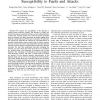130 search results - page 14 / 26 » How to Encrypt with a Malicious Random Number Generator |
EUROCRYPT
2006
Springer
14 years 12 days ago
2006
Springer
We construct a fully collusion resistant tracing traitors system with sublinear size ciphertexts and constant size private keys. More precisely, let N be the total number of users...
INFOCOM
2003
IEEE
14 years 2 months ago
2003
IEEE
— We analyze the susceptibility of the Internet to random faults, malicious attacks, and mixtures of faults and attacks. We analyze actual Internet data, as well as simulated dat...
CVPR
2010
IEEE
14 years 5 months ago
2010
IEEE
Markov random fields (MRFs) are popular and generic probabilistic models of prior knowledge in low-level vision. Yet their generative properties are rarely examined, while applica...
IJCNN
2008
IEEE
14 years 3 months ago
2008
IEEE
— Gene expression based cancer classification using classifier ensembles is the main focus of this work. A new ensemble method is proposed that combines predictions of a small ...
QOSA
2010
Springer
14 years 20 days ago
2010
Springer
Abstract. Software performance prediction methods are typically validated by taking an appropriate software system, performing both performance predictions and performance measurem...

